If you spend enough time fishing small rivers, creeks and lakes you may have asked yourself, what’s the difference between a Warmouth vs Rock Bass?
The truth is, these two species of panfish often get confused with one another even by the most seasoned and expert anglers.
In this article, I’ll tell you everything you need to know to properly identify both Warmouth and Rock Bass, as well as some important biological information that will help next time your out fishing.
Table of Contents
How To Tell The Difference Between Warmouth vs Rock Bass
To tell the difference between a Warmouth and Rock Bass, look for 3 defining characteristics: The number of dorsal fins spines, the number of anal fins spines, and markings around the mouth and eyes.
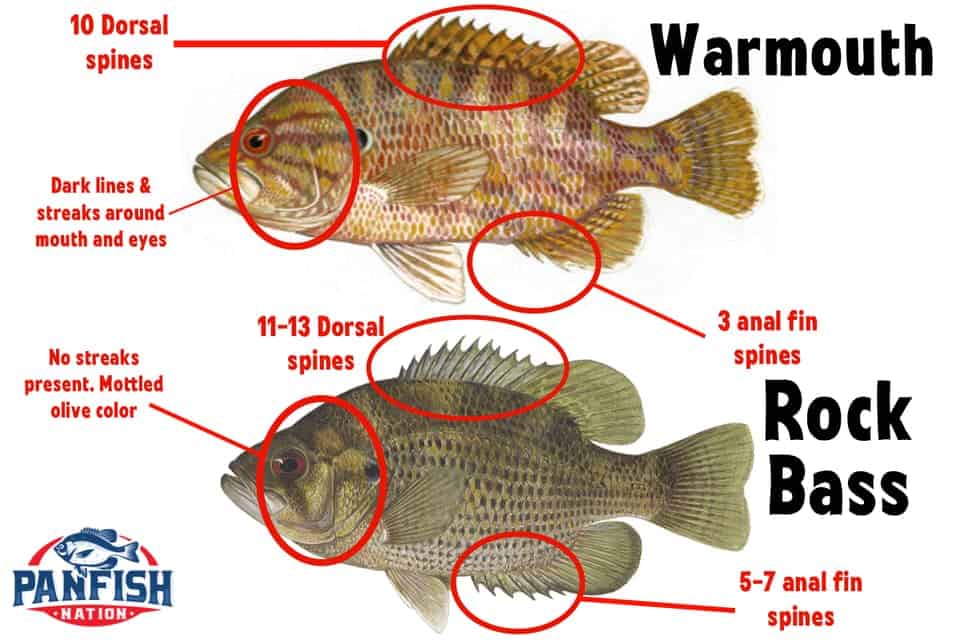
| WARMOUTH | 10 Dorsal Spines | 3 Anal Fin Spines | Dark lines & streaks around eyes and mouth |
| ROCK BASS | 11-13 Dorsal Spines | 5-7 Anal Fin Spines | No streaks around eyes or mouth. |
About Warmouth
Warmouth, or Lepomis gulosus, has many other names such as redeye, goggle-eye and stumpknocker.
Shape, size and coloring
Warmouth is actually somewhat larger than the actual rock bass, with its length ranging from 4 to to 12 inches and weighing up to 2 pounds.
It has a large mouth, much larger than other species of sunfish. It has a medium-large-shaped body and is known for its distinct spines and coloring.
Warmouth have 3 spines on the anal fin, 10 spines on the dorsal fin and have small teeth on their tongue. Males’ eyes turn red during the mating season, hence one of their common names, red-eye.
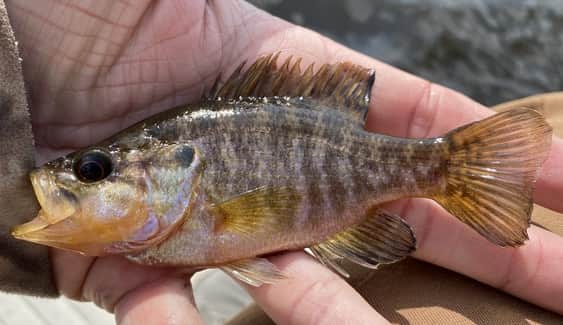
The color patterns of warmouth vary from gold and red to dark green and olive. Irregular stripes or patterns may be present, with most individuals having small orange or red blotch on the operculum (ear flap) and gradually get lighter in color toward the belly.
Habitat
This Warmouth is most frequently found in weedy ditches, and ponds with minimal current as well as in swamps and natural lakes. Warmouth prefer areas with woody cover, such as fallen trees, stumps and heavy vegetation.
Distribution and diet
Warmouth are well-distributed throughout the United States and have been caught in areas ranging from the Great lakes to the Mississippi River basin and from Western Pennsylvania to Minnesota and the Gulf of Mexico. It is most common in the southeast and south central United States.
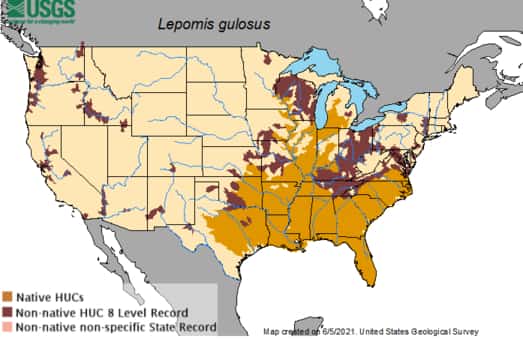
They are a secretive fish that seek cover in areas that include rocky banks, stumps and other large obstructions that allows them to hide and capture prey. The juvenile diet includes zooplankton and small insects, while adults consume insects, mollusks and small fish.
Warmouth Fishing tips
For catching warmouth I like to use a simple live bait rig under a small cork or bobber. A #4 aberdeen hook, or a small #2 circle hook does really well when baited with live worms or crickets.
Find an area that has blown down trees, stumps, cypress roots, or submerged limbs. Sometimes the thicker, the better!
Check out these awesome Warmouth Fishing Decals, perfect for your tackle box, water bottle or other outdoor gear. UV Rated and weatherproof!
Cast your bait near the structure because Warmouth often sit under logs and in the shadows. A small cork will allow you to see the bite and set the hook.
Use 6-10 lb test line, and add a small split-shot weight if necessary. Adjust your float so that the bait is about 6 inches from the bottom.
Warmouth Lures
Most panfish lures will work well when targeting Warmouth, however, the tricky part is not getting snagged in the thick woody areas they call home.
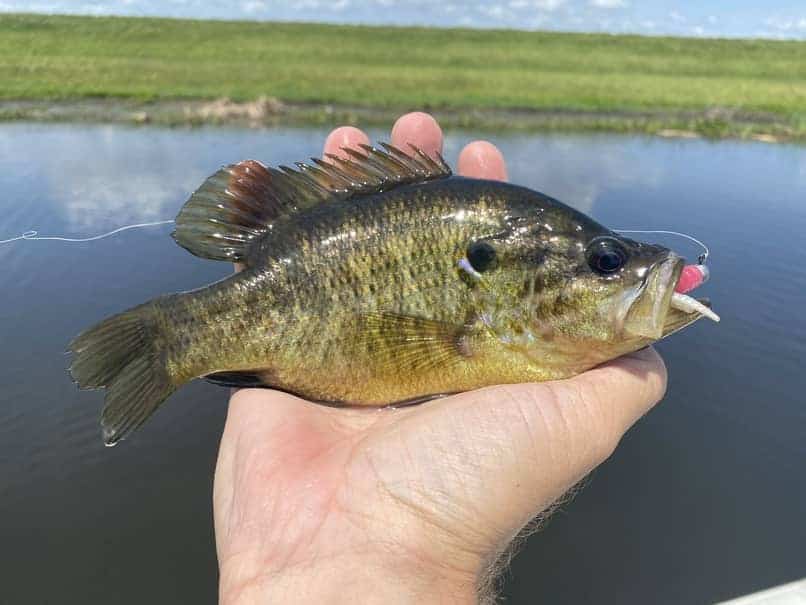
The Beetle Spin, small tube jigs, and mini-swim baits all work very well. If you want to go weedless, consider using a small 4-5 inch Carolina rig and finesse worm.
In fact, Warmouth are often caught by bass fisherman using full-size worms! These fish pack quite the punch and will also hit a variety of flies and poppers, but nothing beats live bait!
About Rock Bass
Despite the common confusion with a Warmouth, the Rock bass, or Ambloplites rupestris, is a different species in the sunfish family that prefers a different type of habitat and is even found in other parts of the country.
Size, shape, coloring
Rock bass average roughly 8 inches in length but rarely grow larger than 12 inches. Their coloring is similar to the warmouth, with olive speckles and a lighter brown belly, though they lack the distinct stripes found around a warmouth’s eyes.
Their eyes can also be reddish, and they have at least 10-12 spines on their dorsal fin and 5-7 on their anal fin.
Habitat
Rock bass are typically found in rivers in their native range, and often associated with ‘flowing water’ such as creeks, drains, and large rivers. They are not usually found in isolated lakes or ponds, however it is possible.
As their name suggests, they are often found near rocky areas such as rock walls, gravel beds, and stone ledges. This rocky habitat is perfect for the rock bass to wait down current for unsuspecting prey to swim by.
Distribution and diet
The native distribution of the rock bass includes the Great Lakes, the Mississippi River drainage basin, Lake Champlain, and the Connecticut and Delaware rivers. It is most common in the midwest and northeastern United States.
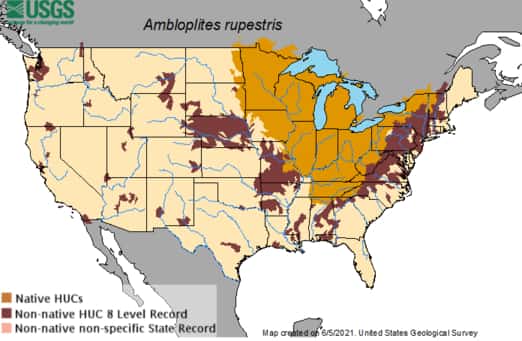
They have been introduced in various areas including New Hampshire, Virginia and, in North Carolina. The primary diet of rock bass includes aquatic insects, crayfish, and small fish.
Rock Bass Fishing tips
Given that rock, bass are more likely to be found in rivers and waters with stronger current, slightly different techniques are recommended than for catching warmouths.
Drift fishing and trolling are reliable if you’re boating. Fish along ledges or drop off and drift live minnows or crawfish, or troll small inline spinners.
Rock bass respond well to most of the bait you would use for panfish such as minnows, wax worms and nightcrawlers.
One of my favorite techniques is to anchor up or fish near the ‘bend’ in a river or creek. Find the ‘eddy’ or calm water caused by water flow and cast out something like a Wordens Rooster Tail.
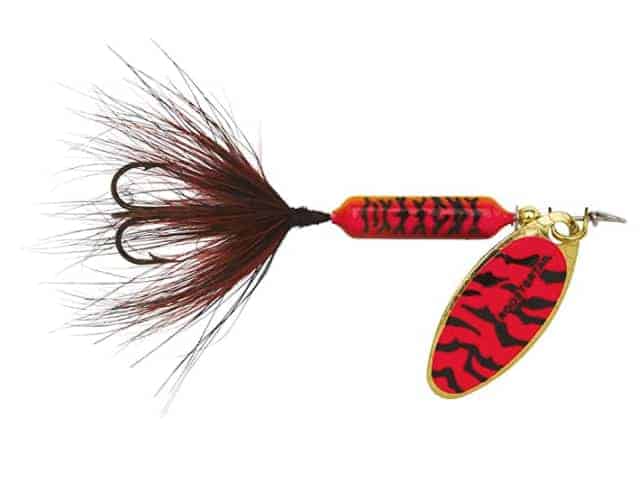
Allow the current to naturally take your bait and swing into the area you think fish are sitting. You’ll want to use a fast-action panfish rod for this type of fishing, but chances are if there is Rock Bass nearby, they won’t resist!
Frequently Asked Questions About Warmouth vs Rock Bass
Which fish, warmouth vs. rock bass, has the larger record holding size?
The largest warmouth ever caught weighed 2 pounds 7 ounces, while the largest rock bass ever caught weighed 3 pounds.
Are warmouth and rock bass good to eat?
Rock bass and warmouth are considered good to eat. Both are well-suited to frying, baking or any fish preparation method you prefer.
What are the catch and size limits for warmouth vs. rock bass?
Fishing regulations vary within each state, such as catch limits being 50 for rock bass in Pennsylvania and 2 in North Carolina; make sure to check your state’s regulations before you go out. The same can be said of the limits placed on warmouth.
How long do warmouth and rock bass live?
Rock bass can live 5 to 8 years, while warmouth live roughly 8 years on average in the wild.
Do warmouth and rock bass form hybrids?
Warmouths have been known to hybridize with bluegills and green sunfish, as they are all in the sunfish family and frequent similar habitats. Rock bass are less likely to hybridize, potentially owing to their frequent and faster-moving bodies of water.
Are Warmouth bad for ponds?
If left unchecked, Warmouth can become overpopulated and disrupt the balance of a pond or lake if your trying to manage for trophy Largemouth Bass. Consult with a fisheries biologist to determine what is best for your pond.
Is a Rock bass the same as a Warmouth?
No, the Rock bass and Warmouth are two completely different and distinct species of sunfish. They are often confused by anglers.
Conclusion
Check on social media or any online forum, and chances are you will see anglers arguing over the correct identification of a Warmouth or Rock Bass.
Although these species have similar characteristics, they are completely different and even share different types of habitat. However, both of them are fun to catch and good to eat!
Now that you know a little more about the differences between Warmouth vs Rock bass you will be ready to settle the debate next time the topic arises!
If you haven’t guessed yet, I love fishing and everything about it!
To learn more about why I started Panfish Nation, visit the About page and follow along on Social Media:


Download a copy of my FREE Lure Color Selection Chart & Knot Guide!
Stay up to date with fishing reports, tackle reviews, industry news, and much more! We respect your privacy, unsubscribe at any time.
- Crazy Facts About the World Record Crappie

- What Size Hooks for Smallmouth Bass? Quick Guide

- Large and in Charge-Mouth: 10 of the Best Bass Lures of All Time (And Where to Buy Them)

- Emperor of the Sun(fish): What You Need to Know About the World Record Bluegill
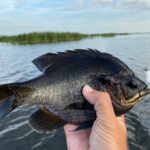
- The Seven Best Lures for Fall Bass Fishing
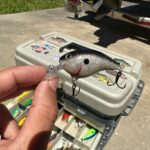
- Which Fishing Line is Best for Bass Fishing With A Spinning Reel?

